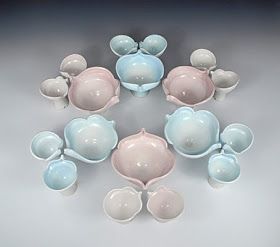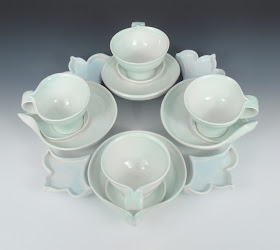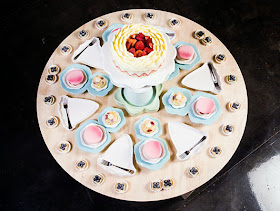Jenny Gawronski is a ceramic artist living and working in southern Colorado. Her work straddles the delicate space between functional pottery and sculptural installation, and it has long captured my imagination. Recently, she began teaching courses at Adams State University and through speaking with her it became apparent that teaching ceramics figures strongly into the vitality of her own artwork. It was just as much a pleasure to speak with her as it is to look at her work.
--------------------------------------------------------------------------------------------------
Jesse Lu: Tell me again about your personal history with clay and how you realized ceramic art was the career you were going to pursue.
Jenny Gawronski: I took my first ceramics class in high school at South High in Minneapolis. I had an incredible teacher named John Kantar, who was very inspiring to all of his students. He studied with Warren McKenzie when he was in college, so we were all introduced to the Japanese Mingei pottery style at a young age. I distinctly remember when I realized that I wanted to work with clay for the rest of my life. I was a junior in high school and I could not get enough time in the studio at school. In my pursuit of learning, I took classes at the Northern Clay Center in Minneapolis and night college classes at the University of Minnesota while I was still in high school. I was just so excited about all of the incredible work that artists were making and became obsessed with learning everything I could about the medium.
JL: I wish my ceramic experience in high school had been like that. Unfortunately, I had a bad teacher who put me off of clay for years. I'm grateful to my mom for encouraging me to give it another go in community college. Have your folks been encouraging of your work?
JG: I am so sorry to hear that! I also teach the art education courses at my university, so the state of art education is very important to me. Good thing for your mom. I am very lucky to have parents that have been very supportive of my pursuit of a life as an artist and educator. My parents have a huge collection of the horrible work that I made in high school and college up in their house in Minneapolis. I wish they would just hide it away in boxes in the basement!
JL: I know what you mean. My mom could have a retrospective of my work from age four on a moment's notice. I'm not so sure how I feel about that.
JG: It is a nice way to see how far our work has developed!
JL: That's a very glass-half-full way to look at it. {laughs}
So... I am going to give you three words to describe your work, they are...
JG: I wish the work would be seen as elegant, ritualistic, and engaging.
JL: I like those choices... And I think they fit well, especially considering the influences I see in your work. If I had to pick two that I see most directly, they would be the geometry of Islamic decoration the gracefulness of Eva Zeisel. How far off am I?
JG: That sounds perfect. One of my favorite books is one that Eva Zeisel wrote called "The Magic Language of Things." Such a great title! Eva Zeisel has had a large influence on my understanding of the importance of craftsmanship in my work. I am always striving for a higher level of craftsmanship as I try to be more confident with the forms of my pieces. I see Eva's work as a great example of those ideas.
With Islamic art, I am inspired by the incredible line quality of the work. I am obsessed with the beautiful shapes that are used in repetition that can be seen in Islamic tile and architecture. I am interested in the over lap of lines to create depth and interest in the work too.
JL: So if you draw aesthetically from those two models of design, can you speak a bit to your conceptual influences?
JG: Conceptually, I am interested in the role of ritualistic objects in our lives. I think a lot about my family’s history in the Jewish faith and the objects that have been used in the past to celebrate yearly rituals. I am interested in the ideas that specific objects can have the power to mark time, and how we can revisit those objects once a year, once a month, or once a week in the use of a specific ritual. I am interested in the possibilities of creating new rituals through the design and placement of objects. This translates into my work creating distinctive sets of ceramic pieces that encourage ceremonial experiences with food for my audience.
JL: I love how your tableaus speak to dining rituals and they make me think about how different meal-culture is from place to place. For instance how traditional Indian cuisine is meant for group eating, with various stews, sauces, and breads served family style with the intention of being shared by hand. What do you think our own dining rituals in this country say about the rest of our culture?
JG: This is a great question. I am very worried about the 'state of the meal' in our country and the larger conversation about obesity. I hope that my work can convey the ideas of eating and drinking as important acts that deserve time and thoughtfulness.
JL: Perhaps also community. I see our eating habits as reflective of the individualism that reigns supreme here in the United States. T.V. dinners, anyone?
JG: Yes, I completely agree with you. I will say that I also struggle with these issues in my own life, too.
JL: It's an inescapable product of our time and place.
So, shifting gears a bit... you've recently begun teaching at Adams State University in Colorado, I assume ceramics. Do you keep a personal studio space there?
JG: Yes, I teach all of the ceramics courses and I have a studio space at school for my glazing and storage and a small space in my house where I create my pieces.
JL: So, greenware happens at home and bisquing onward happens at the university? That sounds dangerous. Especially considering how delicate your forms are.
JG: You are correct, I throw the work at home and wrap it in towels and drive it to school. It is quite a process, but I really love working at home. Because I throw so many different parts and connect them together, I need to get the timing just right. Working at home gives me that opportunity. I also love seeing our 8 chickens running around our backyard from my studio window. They always keep me smiling!
JL: I grew up with chickens. I can't wait for the day I have a space to have them as well. They are such grounding creatures. It must help being able to step back into your little domestic world everyday. "All the ceramic courses" sounds like you're quite busy at the University, and I'm guessing teaching has put a bit of a restraint on how much time you spend working on your art. How does it affect your personal work?
JG: I absolutely love teaching. I get so much energy from the students and it really helps push the work that I am making in my studio. I work in my studio at night and on the weekends, sometimes when I have less available time to work I can stay focused on what I am working on more easily. For example, this summer I have been a little distracted by our mini farm with our chickens, dogs, and cat.
JL: What fantastic distractions, though. What else do you enjoy doing when you aren't teaching or making art?
JG: When I am not in the studio, well even when I am in the studio I spend a fare amount of time eating chocolate and writing letters to friends. I also love running and playing rugby. I have started to sew a little more, which is very exciting!
JL: Rugby? Really?! That's awesome.
JG: Oh, thanks! There is a women's team where you live...
JL: I've been invited to play rugby before. I'm just not very team oriented... {laughs}
I love that you are so into teaching. I just took my first step towards it myself, though I see myself working with really young kids. What is your goal in teaching young ceramists? What do you hope they leave with after being under your tutelage?
JG: I am very interested in what makes an effective teacher. In my ceramics courses I stress the importance of critical thinking and individuality. For all of the assignments that the students have they are asked a series of questions, shown incredible artists, and then they are required to create their own pieces in response to the assignment. We talk a lot about how they each handle the material differently and how that is important for them to pay attention to as they go through life. I also try to stress the importance of taking risks with their ideas and their pieces. I try to help all of the students reach their full potential as artists and critical thinkers.
JL: So... on a final note... What's the best advice you've received from another artist? Or advice that you like to pass on?
JG: I would love to pass on the incredible experiences that I have had with all of my art professors at Penn State, CU-Boulder, and LSU, but there is just too much to share. Instead, I will highlight two very influential LSU professors: Andy Shaw and Tim Berg. Their advice was embodied in demonstrating a strong work ethic and dedication to their studio practice. These artists were extremely generous with sharing their time and knowledge, both while I was enrolled in school and after I graduated. One particular lesson that I have carried with me is their advice to look beyond the typical ceramic influences to find inspiration from authors and other outside sources.
JL: I am definitely a believer in utilizing all the influences around you, especially those furthest from your own medium. It's the most surefire way to reach an original conceptual and aesthetic identity as an artist.
--------------------------------------------------------------------------------------------------
I want to say a HUGE thank you to Jenny for sharing her time with (Mud)Bucket. Interviewing her was an absolute blast and I'm so happy to share our conversation on this blog. Please feel free to share any thoughts or questions in the comments section. Jenny and I would love to hear the reader response.
Also... for future interviews or studio visits... let me know who you would like to hear from. I'd be happy to see if I can make it happen. :)











Impressive work, and great interview! Thanks for sharing this.
ReplyDeleteWow! I really love this artist's work. Does she have a website or a store?
ReplyDeleteThanks
I've linked to the artist's website and shop in the intro where it says 'Website' and 'Shop'. LOL.
ReplyDelete